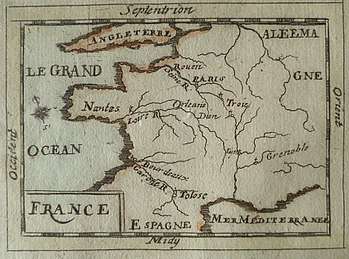Septentrional
Septentrional, meaning "of the north", is a Latinate adjective sometimes used in English. It is a form of the Latin noun septentriones, which refers to the seven stars of the Big Dipper, occasionally called the Septentrion.

| Look up septentrional or septentrion in Wiktionary, the free dictionary. |
In the 18th century, septentrional languages was a recognised term for the Germanic languages.[1]
Etymology and background
The Oxford English Dictionary gives the etymology of septentrional as:
[ad. L. septentrio, sing. of septentriōnēs, orig. septem triōnēs, the seven stars of the constellation of the Great Bear, f. septem seven + triōnes, pl. of trio plough-ox. Cf. F. septentrion.][2]
"Septentrional" is more or less synonymous with the term "boreal", derived from Boreas, a Greek god of the North Wind. The constellation Ursa Major, containing the Big Dipper, or Plough, dominates the skies of the North. The usual antonym for septentrional is the term meridional, which refers to the noonday sun.
Usage
The term septentrional is found on maps, mostly those made before 1700. Early maps of North America often refer to the northern- and northwestern-most unexplored areas of the continent as at the "Septentrional" and as "America Septentrionalis", sometimes with slightly varying spellings.[note 1] Sometimes abbreviated to "Sep.", it was used in historical astronomy to indicate the northern direction on the celestial globe, together with Meridional ("Mer.") for southern, Oriental ("Ori.") for eastern and Occidental ("Occ.") for western.[3]
The linguistic usage in the 17th and 18th centuries was as an umbrella term. It described "the Germanic languages, usually with particular emphasis on Anglo-Saxon, Old Norse and Gothic."[4] Writing of Johann Georg Keyßler in 1758, Thomas Gray distinguished between "Celtic" and "septentrional" antiquities.[5] Thomas Percy actively criticised the blurring of the Celtic and the Germanic in the name of the "septentrional", while at the same time Ossianism favoured it.[6] James Ingram in his inaugural lecture of 1807 called George Hickes "the first of septentrional scholars" for his pioneering lexicographical work on Anglo-Saxon.[7] In current usage, "septentrional fiction" may refer to a setting in the Canadian North.[8]
In France, the term septentrional refers to the Northern stretch of the Côtes du Rhône AOC winemaking region.[9] The Northern Rhône, or septentrional, runs along the Rhône river from Vienne in the north, to Montélimar in the south. It includes the eight crus: Côte Rôtie, Condrieu, Château-Grillet, Hermitage, Saint-Joseph, Crozes-Hermitage, Cornas and Saint-Péray.[10] The Southern Rhône is referred to as the meridional (Rhône méridionale), and extends from Montélimar in the north, to Avignon in the south.
See also
- Septentrionalist
- Oriental
- Occidental
- Boreal
- Austral
Notes
- For example, the "Double Hemisphere" world map, by Moses Pitt, dated about 1680, by labels North America as America Septentriona, to identify the uncharted, northwest of North America.
References
- Workman, Leslie J.; Verduin, Kathleen; Metzger, David; Metzger, David D. (1999). Medievalism and the Academy. Boydell & Brewer. p. 66. ISBN 978-0-85991-532-8.
- "septentrional". Oxford English Dictionary (2nd 1989, online March 2012 ed.). 1989. Retrieved 28 March 2012.
- Hooke, Robert. 1666. Volume 1. Philosophical Transactions.
- Kelsey Jackson Williams, Thomas Gray and the Goths: Philology, Poetry, and the Uses of the Norse Past in Eighteenth-Century England, The Review of English Studies New Series, Vol. 65, No. 271 (September 2014), pp. 694–710, at p. 698. Published by: Oxford University Press JSTOR 24541144
- Gray, Thomas (1853). The Correspondence of Thomas Gray and William Mason: To which are Added Some Letters Addressed by Gray to the Rev. James Brown. R. Bentley. p. 125.
- Kidd, Colin (1999). British Identities before Nationalism: Ethnicity and Nationhood in the Atlantic World, 1600–1800. Cambridge University Press. p. 209. ISBN 978-1-139-42572-8.
- Ingram, James (1807). An Inaugural Lecture on the Utility of Anglo-Saxon Literature. Cooke & Parker. p. 29.
- Woodcock, George (2011). Colony and Confederation: Early Canadian Poets and Their Background. UBC Press. p. 214. ISBN 978-0-7748-4517-5.
- Nord Septentrional
- Huit Crus Celebres